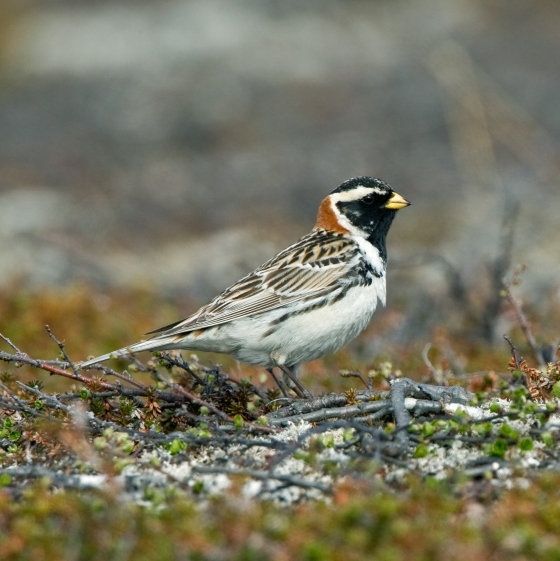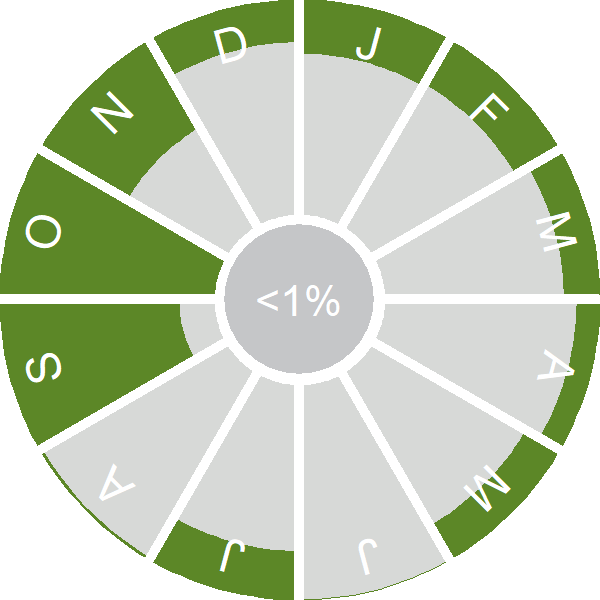Lapland Bunting

Introduction
The chestnut-naped Lapland Bunting is a winter visitor to saltmarshes and coastal fields, where its rolling call often gives it away.
Lapland Buntings begin arriving in Britain & Ireland from their Arctic breeding grounds in late August and early September, with the numbers involved fluctuating between years but typically in the low hundreds. The north-east and east coasts of the UK are favoured, although small numbers of Lapland Buntings can be seen in the south and west too, and across the Irish Sea.
Some of the Lapland Buntings seen in the UK will be birds on passage, heading for wintering grounds in France. Birds begin the journey back to their breeding grounds in March.

Key Stats
Identification
ID Videos
This section features BTO training videos headlining this species, or featuring it as a potential confusion species.
Winter buntings
Songs and Calls
Song:
Alarm call:
Status and Trends
Conservation Status
Population Size
Population Change
Lapland Bunting is a regular, but scarce, winter visitor and is also seen in the UK on autumn passage, predominantly on the North Sea coast [Balmer et al. 2013]. Although there are occasional records of individuals in the breeding season, the species last bred in the UK, in the Scottish Highlands, in 1980 [Holling & the Rare Breeding Birds Panel 2018]. The large apparent range expansion seen between the 1981–84 Winter Atlas and the Bird Atlas 2007–11 has been attributed to a major influx that took place in autumn 2010 as a result of a particularly good breeding season in east Greenland and weather conditions that promoted south-easterly migration [Pennington et al. 2012].
Distribution
Lapland Buntings are very rare breeders of the Scottish Highlands. Breeding was confirmed in the late 1970s though more recently only single birds have been seen in suitable habitat. They are more likely to be seen from autumn onwards when arrivals from Fennoscandia and Greenland arrive to spend the winter. Mostly they are recorded from the coast, particularly along the North Sea coast from the Firth of Forth southward to Kent. There are scattered records from the south coast of England from Kent to Cornwall, on west coasts north to Lancashire, and around the Irish coast. Lapland Buntings are generally scarce inland.
Occupied 10-km squares in UK
or view it on Bird Atlas Mapstore.
or view it on Bird Atlas Mapstore.
European Distribution Map
Distribution Change
The distribution recorded during Bird Atlas 2007–11 represented a 151% increase in range in Britain since the 1981–84 Winter Atlas, with gains most noticeable on western and southern coasts. In Ireland the number of occupied squares increased from one to 15.
Change in occupied 10-km squares in the UK
or view it on Bird Atlas Mapstore.
or view it on Bird Atlas Mapstore.
Seasonality
Lapland Bunting is a scarce winter visitor and autumn passage migrant, mostly in September to November.
Weekly pattern of occurrence
The graph shows when the species is present in the UK, with taller bars indicating a higher likelihood of encountering the species in appropriate regions and habitats.

Movement
Britain & Ireland movement
Foreign locations of birds ringed or recovered in Britain & Ireland
Dots show the foreign destinations of birds ringed in Britain & Ireland, and the origins of birds ringed overseas that were subsequently recaptured, resighted or found dead in Britain & Ireland. Dot colours indicate the time of year that the species was present at the location.
- Winter (Nov-Feb)
- Spring (Mar-Apr)
- Summer (May-Jul)
- Autumn (Aug-Oct)

Biology
Productivity and Nesting
Nesting timing
Egg measurements
Clutch Size
Survival and Longevity
Survival is shown as the proportion of birds surviving from one year to the next and is derived from bird ringing data. It can also be used to estimate how long birds typically live.
View number ringed each year in the Online Ringing Report.
Biometrics
Wing length and body weights are from live birds (source).
Ring Size
Classification, names and codes
Classification and Codes
- Order: Passeriformes
- Family: Calcariidae
- Scientific name: Calcarius lapponicus
- Authority: Linnaeus, 1758
- BTO 2-letter code: LA
- BTO 5-letter code: LAPBU
- Euring code number: 18470
Alternate species names
- Catalan: repicatalons de Lapònia
- Czech: ostružka severní
- Danish: Lapværling
- Dutch: IJsgors
- Estonian: lapi tsiitsitaja e. keltsalind
- Finnish: lapinsirkku
- French: Plectrophane lapon
- German: Spornammer
- Hungarian: sarkantyús sármány
- Icelandic: Sportittlingur
- Irish: Gealóg Laplannach
- Italian: Zigolo della Lapponia
- Latvian: Lapzemes sterste
- Lithuanian: laplandine pentinuotoji starta
- Norwegian: Lappspurv
- Polish: poswierka (zwyczajna)
- Portuguese: escrevedeira-da-lapónia
- Slovak: ostrohárka severská
- Slovenian: ostroglež
- Spanish: Escribano lapón
- Swedish: lappsparv
- Welsh: Bras y Gogledd

